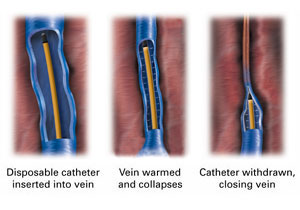(386) 755-0421

The Healthcare Institute (HCI) has been teaching providers and sonographic technicians for many years the techniques of diagnosing and managing Venous Reflux Disease with office based surgical vein closures (ablation, and removal of diseased veins) as well as ambulatory phlebectomy. The Healthcare Institute does cosmetic vein procedures however, our focus is on the management of “symptomatic painful vein disease” (varicosities, swelling, heaviness, fatigue, cramps, etc.) Note that the Healthcare Institute does not use traveling technicians that go from one doctor’s office to the next, but an in house trained staff of nationally certified sonographer’s. Most insurances cover vein closure procedures and when otherwise necessary, payment arrangements can be made. Remember that vein disease can lead to vein clots “thrombosis”, infection, ulcers, and other major complications which can lead to devastating medical complications. Managing vein disease is no simple process and requires a long term commitment to preventative care with a lot of effort by both patients and medical providers. We only do vein procedures when conservative therapy measures have failed in relieving the patient’s discomfort.
Arteries carry “fresh Blood” away from the heart and to the legs as well as all other parts of the body. Veins return the “used blood” full of toxic chemicals (including carbon dioxide and lactic acid) to the center part of the body to be cleaned and filtered by the kidneys, liver, and lungs. The now “fresh blood”, full of nutrients and oxygen, is returned to the heart to be pumped out through the arteries.
Leg veins are equipped with one-way valves designed to prevent blood from flowing backwards in the vein. When those valves no longer function properly because of age, dysfunction, or the distention of the veins, the blood will no longer be sufficiently pushed in the correct direction and can flow backwards (“reflux”) and pool up in the legs. The accumulated blood causes increased pressure in the veins, forcing them to swell, bulge and even leak. The circulatory and skin problems associated with this backup include symptoms identified with varicose veins.

VNUS Closure Procedure
The VNUS Closure procedure is a minimally invasive treatment alternative with less pain and bruising when compared to traditional vein stripping surgery and/or laser treatment. Using the Closure system, physicians close the diseased veins by inserting the closure catheter into a vein and heating the vein wall using temperature-controlled radio Frequency energy. Heating the vein wall causes collagen in the wall to shrink and the vein to close. After the vein is sealed shut, blood then naturally reroutes to healthy veins.

Sclerotherapy
Sclerotherapy is a procedure used to treat spider veins. A medicine is injected into the vessels, which makes them shrink. In ultrasound-guided sclerotherapy, ultrasound is used to visualize the underlying vein so the physician can deliver and monitor the injection. Sclerotherapy is often done under ultrasound guidance after venous abnormalities have been diagnosed with duplex ultrasound.
Phlebectomy
Phlebectomy is a treatment for superficial varicose veins. The procedure involves the removal of the varicose veins through small incisions in the skin overlying the veins. The procedure is performed in an outpatient setting with the patient kept under local anesthesia.